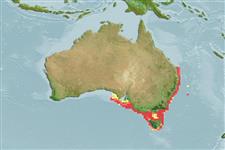>
Eupercaria/misc (Various families in series Eupercaria) >
Sillaginidae (Smelt-whitings)
Etymology: Sillago: From a locality in Australia.
Eponymy: Matthew Flinders (1774–1814) was an English explorer and navigator who joined the British Navy and trained as a navigator, having wanted to be a sailor and explorer ever since reading Robinson Crusoe. [...] (Ref. 128868), visit book page.
Environment: milieu / climate zone / depth range / distribution range
Écologie
marin démersal; océanodrome (Ref. 51243); profondeur 1 - 180 m (Ref. 6205), usually ? - 80 m (Ref. 27575). Temperate; 25°S - 44°S, 132°E - 154°E
Western Pacific: southern Queensland to Anxious Bay, South Australia, and the east coast of Tasmania.
Length at first maturity / Taille / Poids / Âge
Maturity: Lm 14.5, range 14 - 16 cm
Max length : 32.0 cm TL mâle / non sexé; (Ref. 6335); âge max. reporté: 7 années (Ref. 27578)
Épines dorsales (Total) : 12; Rayons mous dorsaux (Total) : 16 - 18; Épines anales: 2; Rayons mous anaux: 18 - 20; Vertèbres: 32 - 34. Coloration is very similar to S. bassensis. No dark spot at the base of the pectoral fin; a series of oblique rusty brown bars on back and upper sides, with a longitudinal row of rusty brown blotches along the midlateral silver stripe.
Live close to the sea bed over sandy substrates. They normally inhabit depths from the surf zone to 80 m (Ref. 27575), although small catches have been taken from deeper water (Ref. 6335). Juveniles congregate in shallow water where they may be taken by line in large quantities. Feed mainly on crustaceans, amphipods, decapods, mysids and copepods. Juveniles consume mostly copepods (Ref. 6223). Oviparous (Ref. 205). Spawn from October to March in southern New South Wales but spawn in winter in southeast Queensland and northern New South Wales (Ref. 6205).
It is likely that this species spawn more than once during the spawning period, and that some eggs are resorbed by females at the end of the spawning season (Ref. 27577).
McKay, R.J., 1992. FAO Species Catalogue. Vol. 14. Sillaginid fishes of the world (family Sillaginidae). An annotated and illustrated catalogue of the sillago, smelt or Indo-Pacific whiting species known to date. Rome: FAO. FAO Fish. Synop. 125(14):87p. (Ref. 6205)
Statut dans la liste rouge de l'IUCN (Ref. 130435: Version 2024-2)
Menace pour l'homme
Harmless
Utilisations par l'homme
Pêcheries: hautement commercial
Outils
Articles particuliers
Télécharger en XML
Sources Internet
Estimates based on models
Preferred temperature (Ref.
123201): 14.1 - 20.1, mean 15.4 °C (based on 166 cells).
Phylogenetic diversity index (Ref.
82804): PD
50 = 0.5000 [Uniqueness, from 0.5 = low to 2.0 = high].
Bayesian length-weight: a=0.00832 (0.00351 - 0.01970), b=3.07 (2.86 - 3.28), in cm total length, based on LWR estimates for this (Sub)family-body shape (Ref.
93245).
Niveau trophique (Ref.
69278): 3.3 ±0.43 se; based on food items.
Generation time: 2.4 ( na - na) years. Estimated as median ln(3)/K based on 1
growth studies.
Résilience (Ref.
120179): Milieu, temps minimum de doublement de population : 1,4 à 4,4 années (K=0.46(?); tm=2; tmax=7; Fec=30,000).
Fishing Vulnerability (Ref.
59153): Low vulnerability (22 of 100).
